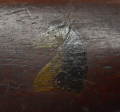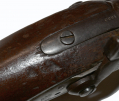site search
online catalog
VERY RARE US MODEL 1830 WEST POINT CADET MUSKET, 36-INCH BARREL: ONE OF JUST ONE HUNDRED AND FIFTY-FOUR MADE FOR WEST POINT

$3,495.00
Quantity Available: 1
Item Code: 490-3492
Shipping: Determined by Method & Location of buyer
To Order:
Call 717-334-0347,
Fax 717-334-5016, or E-mail
The Model 1830 cadet musket was the first musket designed and fabricated specifically for cadets at the US Military Academy, the cadet corps until that time having used the M1817 Artillery Musket, 1807 Indian Carbine with sling swivels added, and (according to Flayderman) other standard arms that had been shortened. This is one of the entirely new muskets for the cadet corps authorized on March 30, 1830, and were assembled at Springfield using a combination of parts fabricated at the Armory, purchased from Robert Johnson of Middletown, CT (identical to parts he was making for the M1817 contract rifle,) and most notably, damascus twist barrels purportedly purchased in Belgium. (For details see Flaydeman, Moller, Vol. 2, and especially, Hanes, ASAC Bulletin 118:5-22.) Although just 300 were authorized, the number produced apparently rocketed up to 307, produced in two different barrel lengths: 36-inches, 154 muskets; and 40-inches, 153 muskets. Though not stated, it is assumed the shorter barrel muskets were to arm the younger, shorter cadets in the lower classes at the academy. (Actual barrel lengths were 36-1/16” and 40-1/16.”) Most of the metal was acid browned and lacquered, with the exception of the case-hardened lockplate, cock and frizzen, and some smaller parts that were heat blued or bright, like the ramrod and pan, the latter of which, like the front sight, was brass. Flayderman gives the caliber as .54, which seems to be a mistake or misprint for .57.
This is a very good example, converted to percussion during the period by a drum-bolster alteration, with the musket and barrel remaining full length- the barrel being 36” version with the correct downsizing of certain elements from the 40” barrel version. All bands, springs, swivels, and the ramrod are in place, as are the bayonet stud and front sight. The wood to metal fit is tight. The metal is smooth, brown, as is correct, with a some mottled light and dark grays on the lock plate, which was casehardened, though the barrel breech shows some gray and shallow pitting from firing percussion caps after the alteration from flintlock, and the barrel shows a few small checks on the right just behind the lower band. The wood rates under that, with good color and surface, no cracks, though showing bumps, scratches and checks, near the lower and upper bands, along the barrel channel, near the breechplug tang, with a small bit of chipping from recoil, all pretty typical of cadet guns, which tend to show rough usage, with the addition of the initials “CA” lightly carved in narrow letters on the left butt flat and a horse’s head, a chess knight, painted on the right butt flat in faded tones. Please see our photos.
The markings for the most part are crisp. The lockplate is stamped forward of the hammer with an eagle looking to the rear over a block letter US with the rear of the plate stamped “SRING / FIELD / 1830.” The barrel shows crisp proofs of a “P” in a sunken oval cartouche with scalloped edges, an eagle’s head, and a “V” on the left breech, with the serial number “122” crosswise just below, and an 1830 date crisply stamped on the breechplug tang, matching the lockplate date. The top of the bayonet lug shows wear, however, and we do not see the serial number stamped there, nor do we see the US on the buttplate tang. Moller notes differences in the style and location of inspection marks on even the small available sample of these arms. We note an “EA” stamped on the forward triggerguard tang (with a small “7,” likely an assembly number, above it. We cannot make out anything on the side flat, but we do see what looks like a small, rubbed letter in the wood just to the rear of the triggerguard tang, a location Moller notes on another cadet musket bearing a block letter “MT.” The musket clearly saw extended use both in flint and percussion, but bands, springs, and rod are in place, the mechanics are tight, and the bore is clean.
This is a very rare, regulation U.S. musket that would fill a gap in pretty much any collection. [cm][ph:L]
~~~~~~~~~~~~~~~~~~~~~~~~~~~~~~~~~~~
THIS ITEM, AS WITH ALL OTHER ITEMS AVAILABLE ON OUR WEB SITE,
MAY BE PURCHASED THROUGH OUR LAYAWAY PROGRAM.
CLICK HERE FOR OUR POLICIES AND TERMS.
THANK YOU!
Inquire About VERY RARE US MODEL 1830 WEST POINT CADET MUSKET, 36-INCH BARREL: ONE OF JUST ONE HUNDRED AND FIFTY-FOUR MADE FOR WEST POINT
For inquiries, please email us at [email protected]
Most Popular
Historical Firearms Stolen From The National Civil War Museum In Harrisburg, Pa »
Theft From Gravesite Of Gen. John Reynolds »
Selection Of Unframed Prints By Don Troiani »
Fine Condition Brass Infantry Bugle Insignia »
British Imported, Confederate Used Bayonet »
Scarce New Model 1865 Sharps Still In Percussion Near Factory New »
featured item
THEFT REPORTED AT AUTUMN GETTYSBURG SHOW
A vendor at the Autumn Gettysburg Civil War show held at the Allstar Events Complex on Oct. 28-29 reported that a Maryland sword belt plate valued at $3500 was stolen from a display case on Sunday afternoon. The Gettysburg Times published a… . Learn More »
site search
Upcoming Events
May 16 - 18: N-SSA Spring Nationals, Fort Shenandoah, Winchester, VA Learn More »

























